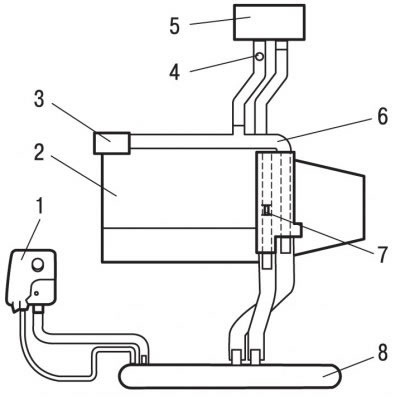
Pic. 3.92. Cooling system: 1 - expansion tank; 2 - cylinder head; 3 - coolant inlet manifold / water pump; 4 - plug holes for air removal; 5 - heater radiator; 6 - coolant outlet block; 7 - thermostat; 8 - radiator
Cooling system includes crankshaft belt driven water pump, electrically driven radiator fan, radiator, expansion tank, heater thermostat and radiator, hoses and switches (pic. 3.92). When starting a cold engine, the coolant does not enter the radiator, since the thermostat valve is closed, but circulates through the jacket of the block and cylinder head and the heater radiator, then again enters the pump. This ensures a quick warm-up of a cold engine. When the coolant reaches a certain temperature, the thermostat valve opens and the hot coolant flows through the hose to the radiator and is cooled by oncoming airflow.
Attention! When opening the expansion tank cap on a hot engine, care must be taken, as escaping vapors can cause severe burns. To do this, close the cap of the expansion tank with a thick layer of cloth and slowly unscrew the cap until a hissing sound is heard. After the hiss stops, slowly unscrew and remove the cap from the expansion tank. Do not allow coolant to come into contact with clothing or body paintwork. Otherwise, rinse the surface with plenty of water. Replace all clamps and clamps that are damaged or cut during disassembly of the cooling system with new ones during assembly. Collect drained coolant and dispose of
